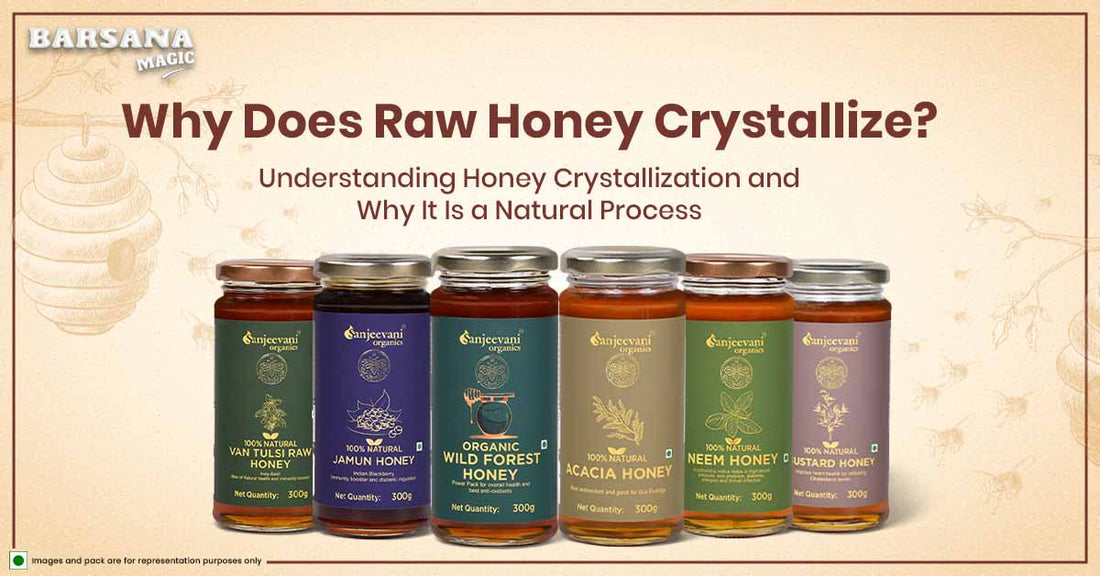Why Does Raw Honey Crystallize ? Understanding Honey Crystallization and Why It Is a Natural Process
Barsana Magic
Honey is one of nature’s oldest and most trusted foods. Known for its natural sweetness and long shelf life, honey has been consumed by civilizations for thousands of years. But if you’ve ever opened a jar and noticed it looking thick, grainy, or even solid—don’t worry. It’s not spoiled or adulterated.In fact, crystallization in raw honey is a natural process and a strong indicator of its authenticity and quality.Let’s understand why raw honey crystallizes, how storage, temperature, and sugar ratios affect it, and why even 100% natural honey from Barsana Magic may crystallize over time.
What Is Honey Made Of ?
Before we explore why honey crystallizes, let’s look at its basic composition. Raw honey is primarily made up of:
- Fructose (38–41%)
- Glucose (31–35%)
- Water (17–20%)
Trace amounts of enzymes, minerals, vitamins, amino acids, and natural pollen
Before we explore why honey crystallizes, let’s look at its basic composition. Raw honey is primarily made up of:
- Fructose (38–41%)
- Glucose (31–35%)
- Water (17–20%)
- Trace amounts of enzymes, minerals, vitamins, amino acids, and natural pollen
Because glucose is less soluble in water than fructose, over time, it tends to separate out and form crystals. This is a completely natural and expected physical change.
Why Does Honey Crystallize?
Crystallization occurs when:
- Honey contains more glucose than the water can hold in solution.
- Glucose separates out and forms tiny sugar crystals.
- The remaining liquid becomes richer in fructose.
This is not a sign of spoilage or added sugar — in fact, raw, unprocessed honey like ours at Barsana Magic often crystallizes faster than filtered or heated honey. It proves the honey is real.
Factors That Influence Crystallization in Honey(h2)
1. Glucose-to-Fructose Ratio(h3)
Different floral sources affect how quickly honey crystallizes.
- High-glucose honeys like Mustard Honey crystallize quickly.
- High-fructose honeys like Acacia Honey stay liquid longer.
2. Moisture Content
- Raw honey usually contains less than 18% moisture, making it more prone to crystallization.
- Processed honey often has higher moisture and additives, which slows the process.
3. Temperature
- Ideal crystallization occurs between 10°C to 15°C (50°F to 59°F).
- Warmer environments slow it down, but may degrade quality if stored long term.
Tip: Avoid refrigeration. Store honey at room temperature in a cool, dry place.
4. Presence of Pollen and Natural Particles
Raw honey from Barsana Magic’s collection retains natural pollen and enzymes, which act as “starting points” for crystals to form.
5. Storage Conditions
- Cool and dark places = faster crystallization
- Sunlight and warmth = delays crystallization but may reduce honey’s natural aroma and enzymes
Is Crystallized Honey Still Good?
Yes, absolutely.
Crystallized honey:
- Has not turned into sugar
- Has not gone bad
- Has no added sugar or adulterants
This is a physical change, not a chemical one. No nutrients are lost, and it retains its enzymes, antioxidants, and beneficial compounds.
How Does Crystallization Affect Taste and Color?
Crystallized honey often:
- Appears lighter or creamier
- Becomes thicker and more spreadable
- Tastes smoother or more intense depending on the floral source
For example:
- Neem Honey may crystallize into a slightly firmer texture.
- Van Tulsi Honey may take on a creamy texture and lighter color over time.
Can You Re-Liquify Crystallized Honey?
Yes. If you prefer liquid honey:
- Place the jar in warm water (below 40°C).
- Stir gently until it returns to its liquid form.
- Avoid using a microwave or high heat, as it can damage nutrients and natural enzymes.
Final Thought: Crystallization Is a Sign of Real Honey
At Barsana Magic, we offer a variety of natural and organic honey:
- Organic Wild Forest Honey
- Jamun Honey (Indian Blackberry)
- Mustard Honey
- Acacia Honey
- Van Tulsi Honey
- Neem Honey
So when you see crystallization in our honey, remember — it’s a mark of purity, not a flaw.
FAQs: Understanding Honey Crystallization
Does crystallized honey mean it’s spoiled?
A. No. Crystallization is a natural process and proves the honey is raw and unprocessed
Can I eat crystallized honey directly?
A. Yes. It’s safe, nutritious, and many people enjoy its creamy, grainy texture.
How do I turn crystallized honey back into liquid?
A. Place the jar in warm water (below 40°C) and stir gently. Never microwave it.
Why does some honey stay liquid for longer?
A. It depends on the flower source. For example, Acacia Honey has more fructose, so it stays liquid longer.
Does crystallization mean sugar was added to honey?
A. No. In fact, added sugar delays crystallization. Natural glucose causes real honey to crystallize.
Which Barsana Magic honey crystallizes the fastest?
A. Mustard Honey crystallizes quickly due to its high glucose content.
Is it okay to store honey in the fridge?
A. It’s not recommended. Refrigeration speeds up crystallization. Store at room temperature instead.
Is crystalized honey better for spreading?
A. Yes! Many people prefer it as a spread due to its thick, creamy texture.




